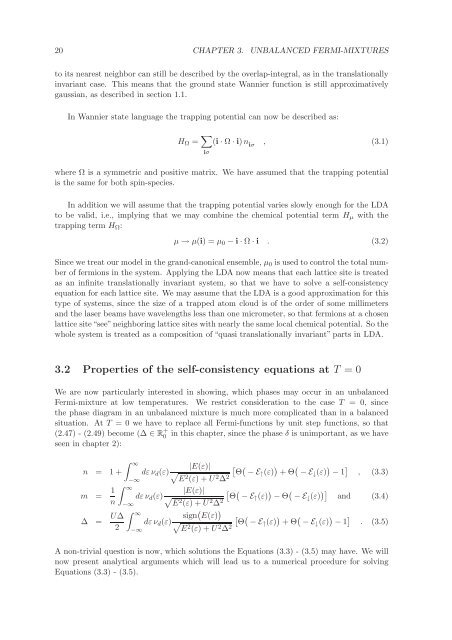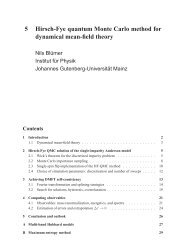Hubbard Model for Asymmetric Ultracold Fermionic ... - KOMET 337
Hubbard Model for Asymmetric Ultracold Fermionic ... - KOMET 337
Hubbard Model for Asymmetric Ultracold Fermionic ... - KOMET 337
Create successful ePaper yourself
Turn your PDF publications into a flip-book with our unique Google optimized e-Paper software.
20 CHAPTER 3. UNBALANCED FERMI-MIXTURESto its nearest neighbor can still be described by the overlap-integral, as in the translationallyinvariant case. This means that the ground state Wannier function is still approximativelygaussian, as described in section 1.1.In Wannier state language the trapping potential can now be described as:H Ω = ∑ iσ(i · Ω · i)n iσ, (3.1)where Ω is a symmetric and positive matrix. We have assumed that the trapping potentialis the same <strong>for</strong> both spin-species.In addition we will assume that the trapping potential varies slowly enough <strong>for</strong> the LDAto be valid, i.e., implying that we may combine the chemical potential term H µ with thetrapping term H Ω :µ → µ(i) = µ 0 − i · Ω · i . (3.2)Since we treat our model in the grand-canonical ensemble, µ 0 is used to control the total numberof fermions in the system. Applying the LDA now means that each lattice site is treatedas an infinite translationally invariant system, so that we have to solve a self-consistencyequation <strong>for</strong> each lattice site. We may assume that the LDA is a good approximation <strong>for</strong> thistype of systems, since the size of a trapped atom cloud is of the order of some millimetersand the laser beams have wavelengths less than one micrometer, so that fermions at a chosenlattice site“see”neighboring lattice sites with nearly the same local chemical potential. So thewhole system is treated as a composition of “quasi translationally invariant” parts in LDA.3.2 Properties of the self-consistency equations at T = 0We are now particularly interested in showing, which phases may occur in an unbalancedFermi-mixture at low temperatures. We restrict consideration to the case T = 0, sincethe phase diagram in an unbalanced mixture is much more complicated than in a balancedsituation. At T = 0 we have to replace all Fermi-functions by unit step functions, so that(2.47) - (2.49) become (∆ ∈ R + 0 in this chapter, since the phase δ is unimportant, as we haveseen in chapter 2):∫ ∞n = 1 +m =1 n∆ = U∆ 2−∞∫ ∞−∞∫ ∞|E(ε)| [ (dεν d (ε) √ Θ − E↑ (ε) ) + Θ ( − E ↓ (ε) ) − 1 ] , (3.3)E 2 (ε) + U 2 ∆ 2|E(ε)| [ (dεν d (ε) √ Θ − E↑ (ε) ) − Θ ( − E ↓ (ε) )] and (3.4)E 2 (ε) + U 2 ∆ 2−∞sign ( E(ε) ) [ (dεν d (ε) √ Θ − E↑ (ε) ) + Θ ( − E ↓ (ε) ) − 1 ] . (3.5)E 2 (ε) + U 2 ∆ 2A non-trivial question is now, which solutions the Equations (3.3) - (3.5) may have. We willnow present analytical arguments which will lead us to a numerical procedure <strong>for</strong> solvingEquations (3.3) - (3.5).













